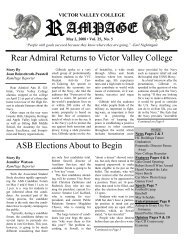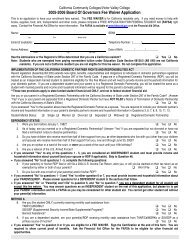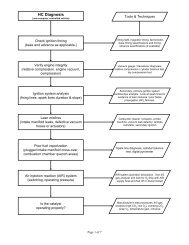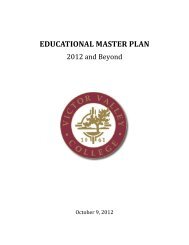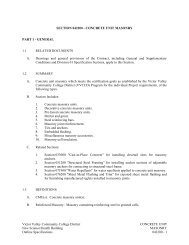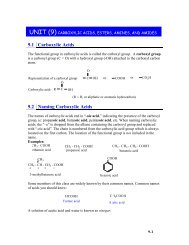Download - Victor Valley College
Download - Victor Valley College
Download - Victor Valley College
Create successful ePaper yourself
Turn your PDF publications into a flip-book with our unique Google optimized e-Paper software.
COLLEGE HISTORY<br />
COLLEGE HISTORY<br />
LOCAL HISTORY OF THE<br />
VICTOR VALLEY<br />
Long before the valley became homesteaded, clean<br />
water pools along the Mojave River offered all sorts of<br />
weary travelers a life sustaining opportunity to halt their<br />
journey and set up camps at a place that would later<br />
become known as the <strong>Victor</strong> <strong>Valley</strong> (named after railroad<br />
engineer, Jacob Nash <strong>Victor</strong> in the late 1800). Lush<br />
green vegetation, access to water, and indigenous<br />
wildlife attracted Native Americans, Spanish<br />
missionaries, settlers in wagon trains coming from Utah<br />
and other points of departure, miners seeking their<br />
fortunes in the gold fields to the north, early explorers,<br />
cowboys herding cattle, and later railroad workers.<br />
The next natural step was the arrival of merchants who<br />
set up shop out of their wagons to feed, supply and outfit<br />
these wayfarers. As the stream of travelers increased,<br />
the first trading post was established in a place that later<br />
became known as Oro Grande. In time, the railroad<br />
completed laying track through the mountains and over<br />
the desert and people began to settle in the region. It<br />
didn’t take long before enterprising land developers and<br />
businessmen and women saw the opportunity to profit<br />
from this influx of people and the region began to grow.<br />
Eventually, the cities of <strong>Victor</strong>ville, Hesperia, and the<br />
Town of Apple <strong>Valley</strong> incorporated between 1962 and<br />
1988. With the commerce, came a need for schools.<br />
The first high school (<strong>Victor</strong> <strong>Valley</strong> High School) was<br />
established in 1915 and served as the only high school<br />
for the next 65 years. Since the mid-80s, more than 20<br />
diploma granting institutions were chartered to facilitate<br />
the needs of an ever expanding population. The next<br />
logical step for the people of the High Desert was to<br />
establish a college to serve the needs of the region. It<br />
was on the campus of <strong>Victor</strong> <strong>Valley</strong> High School that<br />
<strong>Victor</strong> <strong>Valley</strong> <strong>College</strong> began its Tradition of Excellence 50<br />
years ago.<br />
COLLEGE HISTORY<br />
The <strong>College</strong> was originally chartered in 1960 and began<br />
operations in 1961. Classes were held in a small building<br />
that sat on an upper tier of classrooms at the rear of the<br />
high school campus. Only 15 staff, faculty and<br />
administrators were employed to meet the needs of<br />
approximately 500 students. In 1963, it became evident<br />
that the college needed its own space. <strong>Valley</strong> officials<br />
secured the funding through a local bond to purchase<br />
land and begin the construction of a new campus that, at<br />
the time, would be located at the far reaches of the<br />
surrounding communities. Today it is centrally located to<br />
the three major cities in the region. The site contained<br />
260 acres of land, formerly known as the Kalin Ranch,<br />
and featured river valley bottom land and a mesa rising<br />
above the bluff and running parallel to the river. It is on<br />
the mesa that the former cattle ranchers maintained a<br />
large stock pond that would become the focal point of the<br />
campus as it exists today.<br />
The original six buildings still serve students and can be<br />
identified by their signature block design and burnt red<br />
roofs. The campus opened to students in 1965. Since<br />
that time, the campus expanded to include nine new<br />
facilities and a vocation/technical complex.<br />
A wider transformation is taking place at <strong>Victor</strong> <strong>Valley</strong><br />
<strong>College</strong> because of the passage of the first local bond<br />
measure to be approved by the voters since an initial<br />
capital bond was passed in the early 60s. In November<br />
2008, the voters approved a bond measure (Measure JJ)<br />
dedicated to the elimination of past debt, the upgrade of<br />
college infrastructure, the purchase of land for a future<br />
campus sight on the westside of the <strong>Victor</strong> <strong>Valley</strong>, and<br />
funding for the construction of an Eastside Public Safety<br />
Training Center. (See story on page 5.) Additionally,<br />
<strong>Victor</strong> <strong>Valley</strong> <strong>College</strong> completed a one megawatt solar<br />
power generating plant that supplies more than a third of<br />
the campus’ energy needs.<br />
CHANGING EMPHASIS<br />
Today, the <strong>College</strong> is a major institution of higher<br />
learning offering a complex schedule of educational<br />
opportunities to meet the changing needs of this growing<br />
region. The college serves between 14,000 and 17,000<br />
students per semester. This translates into an annual<br />
FTEs of more than 10,000.<br />
Current curriculum includes all the basics for transfer,<br />
degrees, certificates and job training. New areas of<br />
study include innovative programs in solar panel<br />
installation, maintenance and repair; hybrid car<br />
maintenance and repair; GPS studies; land restoration;<br />
digital animation and much more. Nursing still remains<br />
one of the most sought after areas of study offered by<br />
the <strong>College</strong>.<br />
6 2012-2013 <strong>Victor</strong> <strong>Valley</strong> <strong>College</strong> Catalog



